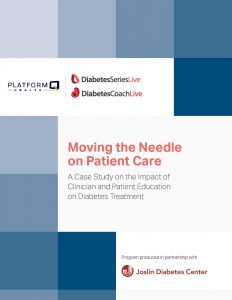Under normal circumstances, managing a complicated health condition can be challenging enough with limited in-person time. Now with COVID-19, doctors are scrambling for new strategies to provide care to their patients, leading to a dramatic increase in the reliance on telemedicine. One solution gaining traction: Tethered education.
Mark was always intentional when it came to his health. He exercised all the time, ate well, took time to focus on his mental health. So, when he was diagnosed with chronic lymphocytic leukemia in 2016, he did what he always does. He dove in, learning as much as he could about his new condition.
“When I was first diagnosed, my oncologist was cut and dry,” Mark explained. “He wanted me to go to FCR [a fludarabine-based treatment regime] after just six months, saying it was the gold standard. I was concerned because I knew we had not run a few relevant tests. After that I got a second opinion, where this time around I felt my doctor was much more engaged with me and understanding of my unique, personal situation. We discussed a range of treatment options based on where I was.”
Mark knew what to ask and how to advocate for himself because he was informed. Unfortunately that is not always the case, which is why it is essential for patients and providers to have a shared understanding of their needs and goals – whatever the health condition may be.
“A real challenge can be this disconnect between what an individual sees as their priorities and what their doctor assumes those priorities are,” said Dr. Richard Beaser, Medical Director of Continuing Medical Education for Joslin Diabetes Center. “For example, with a condition like diabetes, your doctor could be looking at the success of your treatment through clinical outcomes measured by numbers, whereas success for you might be just getting through the day without excessive disruptions from your diabetes to perform tasks of self-care or address an acute issue or problem.”
“While it is easy to overlook, helping individuals and their care providers just communicate and understand each other’s perspectives on goals, barriers, expectations, and treatment plans is fundamental to managing health conditions and improving quality of life,” continued Dr. Beaser.
Despite these challenges, there is one thing patients and providers are on the same page about: They do not spend nearly as much time together as they would like. Nearly 2 out of every 3 patients feel their time with their doctor is limited, and 86% doctors similarly feel their time with patients is not enough. Under normal circumstances, managing a complicated health condition can be challenging enough with limited in-person time. Now with COVID-19, doctors are scrambling for new strategies to provide care to their patients, leading to a dramatic increase in the reliance on telemedicine.

A 2020 Physicians Foundation report found that 15 times as many physicians primarily rely on telemedicine for seeing their patients compared to just two years ago. While COVID-19 is by far the number one cause of the jump in numbers, the majority of physicians (nearly 3 out of 4) strongly believe that they should work to ensure telemedicine remains widely available to patients. “[Telemedicine] represents a sea change in how physicians deliver care,” the report’s authors note.
One proven telemedicine strategy that is gaining traction is tethered education. Also known as aligned education, tethered education is designed as complimentary educational programs built around a single health topic, tailored to meet the different educational needs of patients and doctors.
“The tethered education model is built around the understanding that individuals, their families, and care providers all have different educational needs and challenges,” said Phyllis Foxworth, Advocacy Vice President for the Depression and Bipolar Support Alliance. “For people managing their health conditions, tethered education empowers them to ask questions, identify their health priorities, advocate for themselves, and to take actionable steps in managing their conditions. For providers, it prompts important questions like ‘what are we missing?’ For both, it offers the skills, approaches, and best practices to support shared decision-making and treatment goals.”
Those working on tethered education programs find that success lies in its ability to create a dialogue. In one example, nearly 9 in 10 clinician participants and 7 in 10 patient participants reported improved communication with one another after participating in a tethered program on diabetes treatment.
“With all of the direct-to-consumer advertising out there and the relentless supply of misinformation floating around the internet, doctors often have to spend valuable time deconstructing patient perceptions and expectations,” said June Halper, CEO of Consortium of Multiple Sclerosis Centers. “We can address a lot of those through patient education. Similarly, embedding the patient perspective directly into the clinician education can often lead to powerful revelations among clinician participants related to how their patients manage their condition.”
“While we cannot increase the amount of time doctors and patients spend together, we can ensure that the time they do spend together is as valuable as can be,” continued Ms. Halper. “We want to ensure everyone involved is working towards the same, actionable goals. It is just how patients and providers get there may be a different – yet complementary – path.”
PlatformQ Health partners with leading health care experts and patient advocacy organizations to produce digital education – including tethered programming – across a range of health topics.

